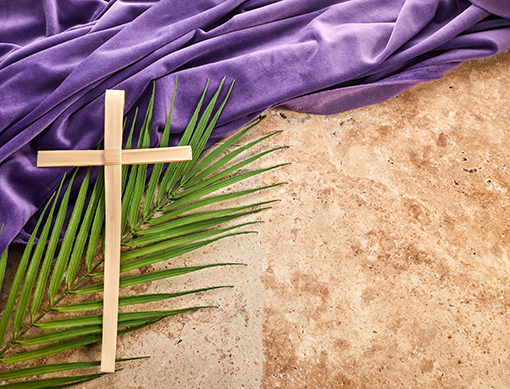Easter is a joyful time full of sacramental blessings. During the Easter Vigil, many of us welcomed new members into our Catholic faith community as they received the sacraments of Baptism, Confirmation, and Eucharist. During the Easter season, many children will receive their First Communions and other Catholics will be confirmed. Celebrating these sacraments of initiation effects the ones receiving them, but everyone in the pews is also reminded of their own faith journey.
 Before it became normative to be a Christian -- because Emperor Constantine made it the state religion in the 3rd century -- the early Christians lived their faith in a society that did not have Gospel values. People were drawn to Christ by the witness of his disciples' lives. Catechesis again has the task of transmitting those values to the next generation, since ordinary culture may not.
Before it became normative to be a Christian -- because Emperor Constantine made it the state religion in the 3rd century -- the early Christians lived their faith in a society that did not have Gospel values. People were drawn to Christ by the witness of his disciples' lives. Catechesis again has the task of transmitting those values to the next generation, since ordinary culture may not.
St. Paul told the early Christians that we are all ambassadors for Christ. God has entrusted to us the Good News (2 Corinthians 5:17-20). New Catholics are watching us to learn how to live their faith. We have a responsibility for every member. Think of it this way: By the way they welcome the candidates as friends and coworkers, everyone in your parish is part of the Christian Initiation team. By the way they treat their own families and friends, everyone is preparing young people for Confirmation and First Communion.
Ambassadors for Christ. Ask children for their ideas for welcoming new Catholics, the newly initiated, first communicants, and recently confirmed. What will make new people feel at home in their parish? What would make them feel welcomed if they moved to a new parish or school?
What Do Sponsors Do? Explain the role of sponsors and godparents play in the ongoing faith journey of the newly baptized and confirmed. Look in the Index pages of your Blest Are We Faith in Action or Be My Disciples program books for lessons on the Sacraments of Initiation.
Acting Out What We Profess. The sacraments do not simply assert something is true; they make that truth more real to us by the sacred symbols, prayers and actions. Spend time with your students reflecting on how each member, new and lifelong, is called to build up the Mystical Body of Christ. We say that the Sacraments are by and for the Church. They are by the Church in that the Church decides how and when they will be celebrated. Sacraments are for the Church because they have power to create us as a community of faith.
Demonstrate Baptism and Confirmation. Show the symbols that are used in the sacraments of Baptism and Confirmation: water and holy oils. Invite students to role play baptism of a baby and a baptism of an adult. Appoint students to play the priest or deacon, godparents and catechumens. For the Sacrament of Confirmation, students will play the roles of the bishop, the confirmandi and their sponsors.
Memories of the Sacraments. Ask your students to share their memories of receiving First Communion, witnessing a baptism, or attending a Confirmation. Some may even recall their own baptism if they were not baptized as infants. Who was there with them?
 About the Author
About the AuthorDr. Lauri Przybysz specializes in equipping families to live their vocation to be domestic churches and signs of God’s love. Lauri received the Doctor of Ministry from the Catholic University of America, and she has been both a Catholic middle school religion teacher and a faith formation coordinator at the archdiocesan and parish levels. She is the mother of six children and grandmother of 21.
In my years working for the Church, I have met many people with varied devotional practices; many, of course, to Mary under her different titles, to Jesus or to the saints, but I never met anyone who had a devotion to the Holy Spirit, until I met my mother-in-law.
 I was married for many years before she mentioned to me her night time ritual of prayers to the Holy Spirit, including praying the Chaplet of the Holy Spirit. When she passed away, I inherited all her religious items, among them a small tin box filled with her devotions to the Holy Spirit.
I was married for many years before she mentioned to me her night time ritual of prayers to the Holy Spirit, including praying the Chaplet of the Holy Spirit. When she passed away, I inherited all her religious items, among them a small tin box filled with her devotions to the Holy Spirit.
What struck me most was that her relationship with the Holy Spirit was on the level of a best friend. From things she had written, I began to have a new understanding of the Holy Spirit as one of three persons of the Holy Trinity.
I came to grasp more fully how valuable that kind of relationship with God can be for youth who are often in need of a comforter, helper, advocate or counselor, or simply put, someone who is always there in time of need. In the Church, April is the month dedicated to the Holy Spirit, and a good time to focus more attention on helping youth develop a relationship with the Holy Spirit. The Cardinal Newman Society proposes that “Catholic education is sustained by the frequent experience of prayer, Sacred Scripture, and the Church’s liturgical and sacramental tradition,’ all of which play a part in the child’s growing understanding of the Holy Spirit.
Praying the Chaplet of the Holy Spirit, either in part or in its entirety depending on students’ ages, is an opportunity to help students connect the chaplet’s five mysteries to events in Sacred Scripture, and follow how the Holy Spirit worked in the life of Jesus and the Church from the time Jesus was conceived until his death and Resurrection, the birth of the Church and continues in the lives of Jesus’ disciples today.
There are also opportunities to build lessons around the Annunciation, the Baptism of Jesus, the seven Gifts of the Holy Spirit, Pentecost and the 12 Fruits of the Spirit.
To learn how to pray the Chaplet of the Holy Spirit click here. While the number and pattern of beads in the chaplet is different, it is still possible to use a regular set of rosary beads if that is what students have.
1st Mystery
By the Holy Ghost is Jesus conceived of the Blessed Virgin Mary (Luke 1:35).
2nd Mystery
The Spirit of the Lord rested upon Jesus when he was baptized (Matthew 3:16).
3rd Mystery
By the Spirit is Jesus led into the desert to be tempted by the devil (Luke 4:1-2).
4th Mystery
The Holy Spirit in the Church (Acts2:2,4).
5th Mystery
The Holy Spirit in the soul of the just man and just woman (1 Corinthians: 6:19; 1 Thessalonians 5:19, and Ephesians 4:30).
Also, during the month of April, consider adding all or part of this prayer to the Holy Spirit to your classroom prayers:
Come, Holy Spirit, fill the hearts of your faithful and kindle in them the fire of your love.
Send forth your Spirit and they shall be created. And you shall renew the face of the earth.
O God, who by the light of the Holy Spirit, did instruct the hearts of the faithful, grant that by the same Holy Spirit we may be truly wise and ever enjoy his consolations.
Through the same Christ Our Lord. Amen.
 About the Author
About the AuthorMary Clifford Morrell, mother of six and grandmother to ten, is a Catholic journalist, editor, and author who has served the Dioceses of Metuchen and Trenton, New Jersey; Burlington, Vermont, and RENEW International in the areas of religious education and communication.
“Nothin’” It seems to be the favorite response of every child when asked, “What did you do in school today?”
 Ask them about how they spent their week, and you may have to sit down and wait a bit for a response. That’s a lot of time territory to cover.
Ask them about how they spent their week, and you may have to sit down and wait a bit for a response. That’s a lot of time territory to cover.
Young children have a tendency to live in the moment, but as they mature they begin to grasp the idea of the past and the future.
The advent of Holy Week is a good opportunity to help children explore the momentous changes that can happen in a week’s time, by examining the last week in the life of Jesus.
This, of course, is a lesson that must be adapted for children of different ages; the last days of Jesus can be difficult for young children to grasp.
So, what exactly happened during the last week in the life of Jesus?
Palm Sunday is the day Jesus rides a donkey into Jerusalem surrounded by people waving palms, laying them on the ground in front of him, and shouting “Hosanna to the Son of David!” By the time of his arrest on Holy Thursday many of these same people will have turned against him.
Holy Monday is the day Jesus and his disciples visited the Temple where Jesus overturned the tables of those who were buying and selling things, and the money changers’ tables as well, saying “My house shall be called a house of prayer’; but you make it a den of robbers.” And the sick and lame came to him in the Temple to be healed. Read St. Matthew 21:12-17
Holy Tuesday saw Jesus continuing to preach, in the Temple to religious leaders who confronted him, and to his disciples who he was trying to ready for what would happen in the next few days, and to help them understand who he was. Read St. John 12:20-38
Holy Wednesday is the time Judas betrayed Jesus for thirty pieces of silver, when “he went away and conferred with the chief priests and captains how he might betray him to them. And they were glad and engaged to give him money. So he agreed, and sought an opportunity to betray him to them in the absence of the multitude.” Read Luke 22:1-6
Holy Thursday was the time of the Last Supper, when Jesus ate with his apostles before the Passover Feast. This meal marked the institution of the Eucharist and the first Mass. On this night, Jesus also washed the feet of his apostles. He then asked Peter, James and John to pray with him in the Garden of Gethsemane, where the three fell asleep. It was here, in the Garden, that Jesus was arrested. Read Mark 14:12-25
Good Friday is the day Jesus is crucified and dies on the Cross. If students have prayed the Stations of the Cross, also called the Way of the Cross, remind them that Good Friday is the day that all those events happened. If they haven’t prayed the Way of the Cross, consider hanging student renderings of each station around the classroom and pray several each day before Good Friday. Read Mark 15:1-47
Holy Saturday finds Jesus in the tomb. You may point out to students that if they go to church on Holy Saturday, they will see the main tabernacle of the church is empty. Jesus is not there. The tabernacle door is left open, and the altar has no covering or decoration. Ask them why.
Holy Week is a time of unparalleled expression of the sacred. It is full of symbols and movement toward the most important celebration of the Church – Easter and the Resurrection of Christ. While students may not be in school for several days of Holy Week, a teacher’s own wonder and awe at what will be transpiring can be contagious, and prepare students to worship well when they have the opportunity.
 About the Author
About the AuthorMary Clifford Morrell, mother of six and grandmother to ten, is a Catholic journalist, editor, and author who has served the Dioceses of Metuchen and Trenton, New Jersey; Burlington, Vermont, and RENEW International in the areas of religious education and communication.
The name “Mary” is used 54 times in the New Testament. The name Mary comes from the Latin and Greek names Maria and Mariam. No matter how many Marys there were, each had a role in the story of salvation. Study about all the Marys to learn how each on participated in Jesus’ mission.
 Mary, the mother of Jesus, is the most well-known Mary in the Bible. She births the Savior for us and cared for him throughout his life. Jesus’ mother was one of three Marys present at his crucifixion. We see these Marys close to Jesus at the end in the gospels of Matthew 27:56, Mark 15:40, and John 19:25.
Mary, the mother of Jesus, is the most well-known Mary in the Bible. She births the Savior for us and cared for him throughout his life. Jesus’ mother was one of three Marys present at his crucifixion. We see these Marys close to Jesus at the end in the gospels of Matthew 27:56, Mark 15:40, and John 19:25.
Mary Magdalene was also present at the cross. She is also known for being the first to see Jesus risen from the dead and reporting the news to the disciples. Her name comes from the city Magdala on the coast of the Sea of Galilee where she was from. This Mary is known for having had seven demons cast out of her by Jesus and then becoming his faithful follower (Luke 8:2). Mary Magdalene recognized the Risen Jesus when he pronounced her name.
Who was the third Mary at the cross? Matthew’s gospel speaks of a Mary who was the mother of Joseph and James, while John’s gospel tells of Mary, the wife of Cleophas. Some say they are the same woman. Along with Mary Magdalene, this other Mary was also one of the first witnesses of Jesus’ Resurrection (Mark 16:1 and Luke 24:10).
More Marys in Scripture. Mary of Bethany was a personal friend of Jesus who enjoyed his company at her home along with her siblings Martha and Lazarus (who was raised from the dead by Jesus). Before Jesus was arrested, he had his feet anointed with costly oil by this Mary. The New Testament tells of still another Mary, the mother of John Mark, who opened her home to the believers for prayer (Acts 12:12). In his letter to the Romans (16:6), St. Paul sends greetings another disciple named Mary, praising her dedication in serving the church in Rome.
A Cloud of Witnesses. Make a list of the Marys that you know. Search the Saints Resource for Marys who are canonized by the Church. Ask students to research other admirable women named Mary in modern times.
Treasuring Our Names: Stop a moment and imagine Jesus calling you by name. Remind students, “You received your name officially at baptism. The priest asked your parents, ‘What name will you give your child?’ Then you were baptized, addressed by that name.”
Art Project: Celebrate your name. Write the letters of your name on a paper, then decorate the letters however you wish. Add color, lines, shapes, or symbols to decorate and celebrate your name. Display the name-icons in the classroom.
Blest Are We Faith in Action Connections: For more opportunities to highlight our personalized call to discipleship, check your grade level program index for ideas related to the theme of Baptism and Vocation.
 About the Author
About the AuthorDr. Lauri Przybysz specializes in equipping families to live their vocation to be domestic churches and signs of God’s love. Lauri received the Doctor of Ministry from the Catholic University of America, and she has been both a Catholic middle school religion teacher and a faith formation coordinator at the archdiocesan and parish levels. She is the mother of six children and grandmother of 21.
Lent is our greatest season of hope because it awaits the great mystery of Jesus resurrection on Easter morning. Hope means “to want and expect.” Christians hope in Christ and that hope will not disappoint us (Romans 5:5). It is a feeling that what is wanted will happen. We pray during Lent and throughout the year, that God will empower us to be positive and help us also seek and see the goodness in one another. We can help our students to look at the world with hopeful eyes. When we have hope, our outlook on the world will be more optimistic.
 One of the most important habits of mind that children can develop is optimism. Pessimism, on the other hand, leads to helplessness and withdrawal – it doesn’t matter what I do, it won’t work, so there is no point in trying. Optimism is not about temperament; it is a habit of thinking that relates to how we interpret events. And it can therefore be taught.
One of the most important habits of mind that children can develop is optimism. Pessimism, on the other hand, leads to helplessness and withdrawal – it doesn’t matter what I do, it won’t work, so there is no point in trying. Optimism is not about temperament; it is a habit of thinking that relates to how we interpret events. And it can therefore be taught.
Optimism has been found to be one of the key characteristics of resilient people. The brain can be rewired to be more optimistic through the experiences it is exposed to. This doesn’t mean invalidating one’s pessimistic feelings. Acknowledge their view of the world, and introduce them to a different one. Children who practice optimistic thinking are more resilient, they are less likely to give up in the face of challenge, and they tend to interpret experiences in a way that gives them a sense of control and confidence.
Prayer Treasure Chest. Materials: shoe box or other box with a lid, old magazines, scissors, glue, stickers, colorful paper. Students cut out pictures that remind them of hope and love, and glue them on the box. Have students write (or help little ones write) three prayers on separate slips of paper and place the prayers in the Treasure Chest. Before faith formation class begins, ask each person to draw out a prayer to read privately to themselves. Close the silent prayer time with a prayer for the group to hope in Christ. Make time for everyone to add more prayers and intentions in the coming weeks.
Rice Bowl of Hope. Materials: bowl, paper, and pen. Or use an Operation Rice Bowl box from Catholic Relief Services. One way of sharing hope with others is by giving alms. Plan to conserve one meal a week and use the money for the Rice Bowl. At the end of Lent, give the money to your local poor or to Catholic Relief Services.
Popcorn Reflection. Make some popcorn, and discuss how the kernels change and become transformed. (The good food was hidden within the hard shell.) Share ideas on how we can be compared to popcorn in our own lives. Can you think of another food metaphor for hidden blessings?
Sharing Our Optimism Stories. Invite students to work with a partner or a small group.
• Each share a story about a hope he or she had and how things worked out.
• Share a funny story about him or herself.
• Share a time you felt especially cared for by someone.
 About the Author
About the AuthorDr. Lauri Przybysz specializes in equipping families to live their vocation to be domestic churches and signs of God’s love. Lauri received the Doctor of Ministry from the Catholic University of America, and she has been both a Catholic middle school religion teacher and a faith formation coordinator at the archdiocesan and parish levels. She is the mother of six children and grandmother of 21.
In this culture of social media, messaging is something to which youth can easily relate.
 For them, messages may be sent and returned in an instant, without any personal interaction at all. But Scripture teaches us that in the time of the Hebrew people, messages often came with the aid of an angel.
For them, messages may be sent and returned in an instant, without any personal interaction at all. But Scripture teaches us that in the time of the Hebrew people, messages often came with the aid of an angel.
Those were the messages you didn’t want to miss because they were messages from God.
Among those very important messages was the most important one for humanity, in which the Angel Gabriel came to a young Jewish woman to tell her God had chosen her to be the mother of the savior of the world – Jesus, the Son of God.
We can only imagine how this message, and this opportunity, confused all of Mary’s plans for what her life would be like,” and yet she listened to Gabriel’s words, “Be not afraid,” and offered her freely chosen “yes” to God.
This marked the moment Jesus was conceived through the power of the Holy Spirit. This life-changing message for Mary and whole of humanity, and Mary’s response, is celebrated as the Solemnity of the Feast of the Annunciation of the Lord on March 25.
And, though in the middle of Lent, the Annunciation is a feast of joy. The liturgical color is white instead of the Lenten purple, and, unlike during Lent, the Gloria is sung at Mass. Also, a solemnity is the highest-ranking feast in the liturgical calendar, certainly appropriate for the event which brought God into the world as one of us.
And there, at the heart of the story, is the Archangel Gabriel, sent as God’s messenger.
We see this often in Scripture, God using his angels as messengers, to enlighten, protect and lead people to God. In a 2018 homily, Pope Francis recalled God’s words to Moses from the Book of Exodus: “Behold, I send an angel before you, to guard you on the way and to bring you to the place which I have prepared.”
In a 2018 homily on the Feast of the Guardian Angels, Pope Francis spoke about life as a journey and shared some interesting thoughts about angels, and their importance in our lives:
• “There is the danger of not going on the journey. And how many people settle down, and don’t set out on the journey, and their whole life is stalled, without moving, without doing anything…The angels help us, they push us to continue on the journey.”
• “I want to ask you a question: Do you speak with your angel? … Do you listen to your angel? Do you allow yourself to be led by hand along the path, or do you need to be pushed to move?”
• “Our angel is not only with us; he also sees God the Father. He is in relationship with Him. He is the daily bridge; from the moment we arise to the moment we go to bed. He accompanies us and is a link between us and God the Father. … Let us not forget these companions on the journey …”
Spend some time reflecting on the words of Pope Francis and consider your own relationship with the angels, especially your own guardian angel. Then reflect on how you can help your students learn more about the angels. Consider the following:
Pray the Guardian Angel Prayer with your students as often as you can. Repetition will enable students to memorize the short prayer and pray it when they feel the need of courage or comfort – Angel of God, my guardian dear, to whom God’s love commits me here; Ever this day be at my side, to light and guard, to rule and guide. Amen
Encourage children to listen to their angels, especially when making difficult decisions – This is a process of discernment, prayer and time to ask for and listen for guidance. It prevents hasty decisions that often lead to very big mistakes.
Encourage your students to create an artistic rendering of their guardian angel – We don’t know what angels look like, but giving children the opportunity to imagine their angel will help them give form and shape and personality to a protector given to them by God.
Take to heart the words of St. Pope John Paul II – "Teach the children that they are never alone, that an angel is at their side. Show them how to have a trusting conversation with the angel, who is a good advisor and intercedes for you and helps you in your needs." – St. Pope John Paul II
 About the Author
About the AuthorMary Clifford Morrell, mother of six and grandmother to ten, is a Catholic journalist, editor, and author who has served the Dioceses of Metuchen and Trenton, New Jersey; Burlington, Vermont, and RENEW International in the areas of religious education and communication.
What allows us to respond to God’s grace? The answer is: God’s grace! God does not wait until we are ready, until we are prepared and certainly not until we are deserving. Rather, God gives us grace so that we may know and respond further to the grace we are given. How will we respond to such great gifts?
 Because God is love, God’s grace is a gift of love that invites us into relationship with God, the source of our existence. God is truly present to us in the Eucharist and all the Sacraments, offering us the free gift of his grace – his very Self. God’s grace is also to be found in the ordinary events of our lives. The sacred hides in the stuff of our lives; the holy does not inhabit a distant realm beyond us. All created things are signs of God that we decipher in order to find our way to God. We can explore with students the varied ways we can unwrap this divine gift.
Because God is love, God’s grace is a gift of love that invites us into relationship with God, the source of our existence. God is truly present to us in the Eucharist and all the Sacraments, offering us the free gift of his grace – his very Self. God’s grace is also to be found in the ordinary events of our lives. The sacred hides in the stuff of our lives; the holy does not inhabit a distant realm beyond us. All created things are signs of God that we decipher in order to find our way to God. We can explore with students the varied ways we can unwrap this divine gift.
Responding in Prayer. Jesus has taught us the perfect way to pray in the Lord’s Prayer. The Lord’s Prayer has all various kinds of prayer in one: God’s name is glorified, his plans for creation be fulfilled, we realize how God cares for us and gives us what we need, our daily bread and forgiveness of our sins. We pledge to forgive others, confident that God will defend us from harm. This is the tradition of the Church to pray the Lord’s Prayer three times a day. If we do this, our relationship with God will be in right order and so will your priorities. When will your class pray the Lord’s Prayer during the school day?
Responding by Remembering. Sometimes our prayer can get formal and abstract. St. Ignatius taught his followers to examine their lives each day and learn to recognize God’s will in the reality of the situation. It is called the Daily Examen. The Daily Examen keeps our feet on the ground. This reflective, Spirit-led review of the day grounds our prayer in concrete reality. Because we are God’s sons and daughters living in a world that he loves and sustains, we can be assured that we can hear his voice in our lives in this world.
Responding with Gratitude. Ultimately, our response to God’s grace must be to thank him. The more we give thanks, the more we are expressing of our awareness of our reliance on God. Our response includes a change in attitude. When we realize that it is God’s world and God’s work we are invited to join, we will gain a new perspective on life.
Responding in Action. God’s grace will lead us to be Christ to others and equip us with courage to do his will. After hearing the message of Catholic teaching, students should identify ways to be a blessing to others through their words and deeds. Plan each week to emphasize the Respond element of your faith formation lessons in Blest Are We Faith in Action.
 About the Author
About the AuthorDr. Lauri Przybysz specializes in equipping families to live their vocation to be domestic churches and signs of God’s love. Lauri received the Doctor of Ministry from the Catholic University of America, and she has been both a Catholic middle school religion teacher and a faith formation coordinator at the archdiocesan and parish levels. She is the mother of six children and grandmother of 21.
Our Church has benefited from the witness of so many women who have brought Christ into challenging situations, at home and around the world. We may know them as “Grandma” or “Auntie,” or see their names in the lists of Saints we revere during the Mass, like “Perpetua and Felicity.” Jesus welcomed the ministry of his friends Mary Magdalen, Martha, and our blessed mother, Mary, to his disciples. Today, Catholic women have many important and influential roles as witnesses for Christ that are irreplaceable in Church, in their families and society.
 Pope John Paul II praised the dignity and vocation of women in his apostolic letter, Mulieris Dignitatem: “Even in the face of serious social discrimination, holy women have acted ‘freely,’ strengthened by their union with Christ. …In every age and in every country we find many ‘perfect’ women (cf. Prov. 31:10) who, despite persecution, difficulties and discrimination, have shared in the Church’s mission” (no.27).
Pope John Paul II praised the dignity and vocation of women in his apostolic letter, Mulieris Dignitatem: “Even in the face of serious social discrimination, holy women have acted ‘freely,’ strengthened by their union with Christ. …In every age and in every country we find many ‘perfect’ women (cf. Prov. 31:10) who, despite persecution, difficulties and discrimination, have shared in the Church’s mission” (no.27).
One such witness for Christ is Dorothy Stang. Sister Dorothy, of the Congregation of Notre Dame de Namur, originally from Dayton, Ohio, spent 30 years ministering at the edge of the Trans-Amazon Highway in Brazil. There she made many enemies in high places because of her work in defense of the poor. Her life was repeatedly threatened. Sister Dorothy served and worked alongside landless and indigenous people who lived in the shadow of rich, powerful loggers and ranchers. She stood alongside her neighbors in working for land reform, the rights of rural workers, and in defending the land of small farmers. In 2005, at the age of 73, she was shot at point-blank range by a gunman hired to silence her voice forever. Her murder followed a dispute with wealthy, powerful ranchers over land they intended to clear for pasture and which she had sought to protect. The night before she was killed, she had brought food and clothing to a family whose home had been burned down. Sister Dorothy is remembered for faithfully putting her faith into action for the poor. Books, movies, documentaries and an opera have been developed about her. She is not canonized yet, but she has been officially recognized by the Church as a martyr.
Women who made a difference. Ask students to describe a woman that has been important in their lives. They could write a story or draw a portrait. If she is living, they could write her a letter.
Explore stories of other woman martyrs in your Be My Disciples or Blest Are We Faith in Action program books. More holy women are featured in the Saints Resource.
Consider these questions for yourself, and then adapt these them to the level of your students:
• In what situations is it most difficult for you to witness to your beliefs? What concerns or circumstances lead you to fail to proclaim the Gospel in word and deed?
• What aspects of your life circumstances enable you to put your faith into action? Does something constrain you from living the Gospel and talking about your faith?
 About the Author
About the AuthorDr. Lauri Przybysz specializes in equipping families to live their vocation to be domestic churches and signs of God’s love. Lauri received the Doctor of Ministry from the Catholic University of America, and she has been both a Catholic middle school religion teacher and a faith formation coordinator at the archdiocesan and parish levels. She is the mother of six children and grandmother of 21.
St. Patrick is a saint who is both widely celebrated and not well-known. Though he is the patron saint of Ireland, he isn’t Irish. Though he was a bishop, he wasn’t always a believer. Though he served the people of Ireland, it wasn’t love at first sight.
 St. Patrick’s story is an interesting narrative of contradictions, and a wonderful example of how the road of life, filled with obstacles and what we think are wrong turns, can still lead to fulfilling your God-given purpose.
St. Patrick’s story is an interesting narrative of contradictions, and a wonderful example of how the road of life, filled with obstacles and what we think are wrong turns, can still lead to fulfilling your God-given purpose.
Patrick was born in Britain to a wealthy family. At the age of 16, he was captured by Irish pirates and taken back to Ireland where he spent six years in forced servitude tending sheep. He was not well-treated, struggled with loneliness, hunger and cold. In his, Confessio, Patrick admitted, “I did not then believe in the living God, not even when I was a child.”
In these difficult times, a young Patrick eventually turned to God. One night, in his dreams, he had a vision of a boat waiting on shore and a voice telling him it was time to go home. Patrick believed the voice to be God’s, so he escaped from his captivity and walked 200 miles to the coast of Ireland where he did find a boat heading back to Britain.
Once home, he again had dreams in which he heard voices calling to him. He understood them to be the voices of the Irish people calling to him to come back. Which he did, after years of preparing for the priesthood and eventually being ordained a bishop at age 43.
St. Patrick made great inroads with the Irish people, as he was totally focused on bringing the Gospel of Jesus to the people he had grown to love. Today he is the patron saint of Ireland, and his feast day, March 17, is celebrated worldwide, and with it the cultural heritage of the Irish people. It is also an optional memorial in the Catholic liturgical calendar.
Like so many holidays with a religious basis, St. Patrick’s Day has become secularized and commercialized in contemporary culture. A celebration of good times and good luck is filled with Images of leprechauns, rainbows and pots of gold, corned beef and cabbage dinners, reasons to indulge in frosty mugs of beer, and enjoyable, to be sure.
As educators we can ensure that students enjoy the celebration without losing the spiritual significance of St. Patrick.
Celebrating St. Patrick’s Day as a Catholic holiday:
Discuss the life of St. Patrick – Introduce students to the life of St. Patrick. According to their age, ask students questions they must answer with more than a yes or no. You might begin with “What surprised you about St. Patrick?” “Do you pray to God when you are alone or afraid?” “How did St. Patrick’s love of God make other people’s lives better?”
Teach about the Trinity – Tradition says that St. Patrick taught the Irish to understand three persons in one God by using shamrocks, a small clover-like plant with three leaves on one stem, to illustrate the Holy Trinity as three persons in one God. Like Jesus, who also used images and stories to teach, St. Patrick used the shamrock, now the national emblem of Ireland, to make the mystery of God accessible to the Irish people.
Include a lesson on the role of bishop – Check your curriculum texts for opportunities to discuss the role of bishops in the Church. Images of St. Patrick often portray him with a staff in one hand and shamrocks in the other. Include explanations of a bishop’s mitre, staff, coat of arms, all perfect subjects for an art class. Encourage students to create their own coat of arms, using images from religion classes – doves, flames, wheat, crowns, hearts, crosses or angel wings, as examples.
For teachers – Perhaps the best way to get to know St. Patrick is to read his touching and inspiring Confessio, written by him while in Ireland. We are introduced to St. Patrick as a humble man with unwavering trust in God, who shares many of his trials and tribulations while serving the Irish people. He closed his Confessio with these words:
“I pray for those who believe in and have reverence for God. Some of them may happen to inspect or come upon this writing which Patrick, a sinner without learning, wrote in Ireland. May none of them ever say that whatever little I did or made known to please God was done through ignorance. Instead, you can judge and believe in all truth that it was a gift of God. This is my confession before I die.”
 About the Author
About the AuthorMary Clifford Morrell, mother of six and grandmother to ten, is a Catholic journalist, editor, and author who has served the Dioceses of Metuchen and Trenton, New Jersey; Burlington, Vermont, and RENEW International in the areas of religious education and communication.
Conflict is a disagreement or problem that happens between two or more people. It can happen to anyone, from best friends to enemies, whatever their age groups or family situations. Most conflicts start small, but they continue to grow, snowballing into major problems, breaking the peace in our homes and classrooms. Conflict resolution is an important skill to have, both in the classroom and in life, and worthy content for faith formation.
 As Catholic teachers, we are able to bring the wisdom of the Scriptures and our faith tradition into the conversation. When there’s a problem, it’s important to address the problem in a peaceful way, understanding both sides of the situation. Teach children to solve problems peacefully and resolve conflicts independently. By helping our students practice and adopt healthy ways of solving interpersonal problems, we help them succeed in other areas of their education and life as well.
As Catholic teachers, we are able to bring the wisdom of the Scriptures and our faith tradition into the conversation. When there’s a problem, it’s important to address the problem in a peaceful way, understanding both sides of the situation. Teach children to solve problems peacefully and resolve conflicts independently. By helping our students practice and adopt healthy ways of solving interpersonal problems, we help them succeed in other areas of their education and life as well.
Peacemakers and Peacebreakers. Have children help you make a list of situations that break the peace in a relationship. Some examples: Yell and scream. Interrupt. Fight. Tell lies. Use hurtful words. Then brainstorm ways to bring peace to a situation. Some examples: Ask for help. Use kind words. Apologize. Take turns.
Role Play with Puppets. Make and use puppets to role play scenarios of peacemaking and peace breaking that children encounter. You can role-play resolving conflict with a bully, fixing a friendship after a fight, or getting along with a sibling.
How to Deal with a Bully, Dr. Tim Hogan’s article within RCL Benziger's Flourish for Family Life offers background you can use in the classroom to help children resolve conflicts they encounter from bullies. Discover more about conflict resolution and peacemaking in the Family Life series lessons.
Wisdom from Scripture. The Bible offers guidance to people of faith about resolving conflicts. Ask students to choose one of the Bible messages that can guide them in resolving in the conflicts that they listed or role-played. Ask them to explain why this Scripture verse is helpful.
• Preserve unity: “…making every effort to maintain the unity of the Spirit in the bond of peace.” Ephesians 4:3.
• Be a peacemaker: “Blessed are the peacemakers, for they will be called children of God.” Matthew 5:9.
• Put the interests of others ahead of your own: “Let each of you look not to your own interests, but to the interests of others.” Philippians 2:4.
• Seek the wisdom of God: “For where there is envy and selfish ambition, there will also be disorder and wickedness of every kind. But the wisdom from above is first pure, then peaceable, gentle, willing to yield, full of mercy and good fruits, without a trace of partiality or hypocrisy. And a harvest of righteousness is sown in peace for those who make peace.” James 3:16-18. • Pray: “Therefore confess your sins to one another, and pray for one another, so that you may be healed. The prayer of the righteous is powerful and effective.” James 5:16.
Expressing Peace through Art. Encourage children to draw a picture to depict a story that includes a problem between friends. Make Origami Peace doves (Do a Google search for directions.) Place these doves around your classroom as a reminder of our call to be “People of Peace.”
 About the Author
About the AuthorDr. Lauri Przybysz specializes in equipping families to live their vocation to be domestic churches and signs of God’s love. Lauri received the Doctor of Ministry from the Catholic University of America, and she has been both a Catholic middle school religion teacher and a faith formation coordinator at the archdiocesan and parish levels. She is the mother of six children and grandmother of 21.
Pagination
Latest
Categories
Archives
- February 2015 (2)
- March 2015 (2)
- April 2015 (5)
- May 2015 (3)
- June 2015 (6)
- July 2015 (3)
- August 2015 (5)
- September 2015 (5)
- October 2015 (4)
- November 2015 (2)
- December 2015 (1)
- February 2016 (2)
- March 2016 (1)
- April 2016 (2)
- May 2016 (2)
- July 2016 (2)
- August 2016 (2)
- September 2016 (1)
- October 2016 (5)
- November 2016 (1)
- December 2016 (3)
- January 2017 (2)
- February 2017 (3)
- March 2017 (2)
- April 2017 (1)
- June 2017 (2)
- July 2017 (2)
- August 2017 (1)
- April 2018 (1)
- October 2018 (2)
- December 2018 (2)
- February 2019 (3)
- March 2019 (2)
- April 2019 (2)
- May 2019 (3)
- June 2019 (1)
- July 2019 (16)
- August 2019 (8)
- March 2020 (4)
- April 2020 (6)
- May 2020 (8)
- June 2020 (7)
- July 2020 (5)
- August 2020 (7)
- September 2020 (4)
- October 2020 (5)
- November 2020 (9)
- December 2020 (11)
- January 2021 (10)
- February 2021 (8)
- March 2021 (5)
- April 2021 (4)
- May 2021 (4)
- June 2021 (5)
- July 2021 (2)
- August 2021 (3)
- September 2021 (4)
- October 2021 (4)
- November 2021 (2)
- December 2021 (5)
- January 2022 (4)
- February 2022 (4)
- March 2022 (9)
- April 2022 (7)
- May 2022 (9)
- June 2022 (12)
- July 2022 (7)
- August 2022 (10)
- September 2022 (9)
- October 2022 (11)
- November 2022 (8)
- December 2022 (7)
- January 2023 (2)
- February 2023 (10)
- March 2023 (9)
- April 2023 (10)
- May 2023 (8)
- June 2023 (4)
- July 2023 (3)
- August 2023 (2)
